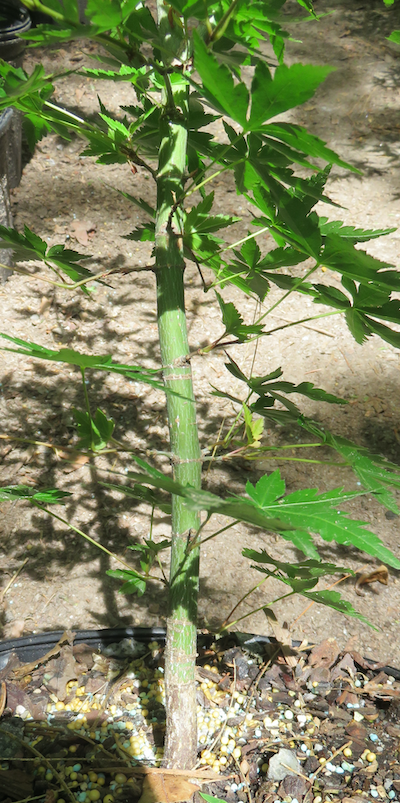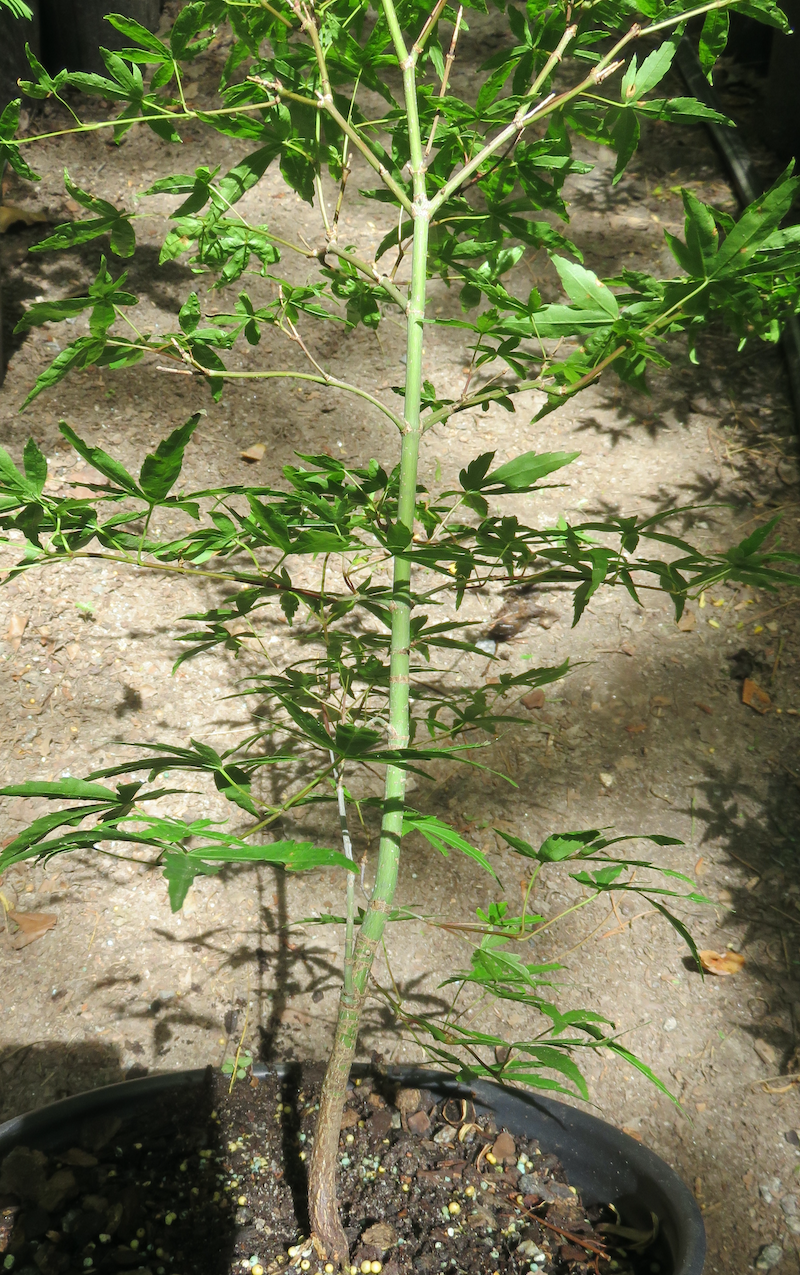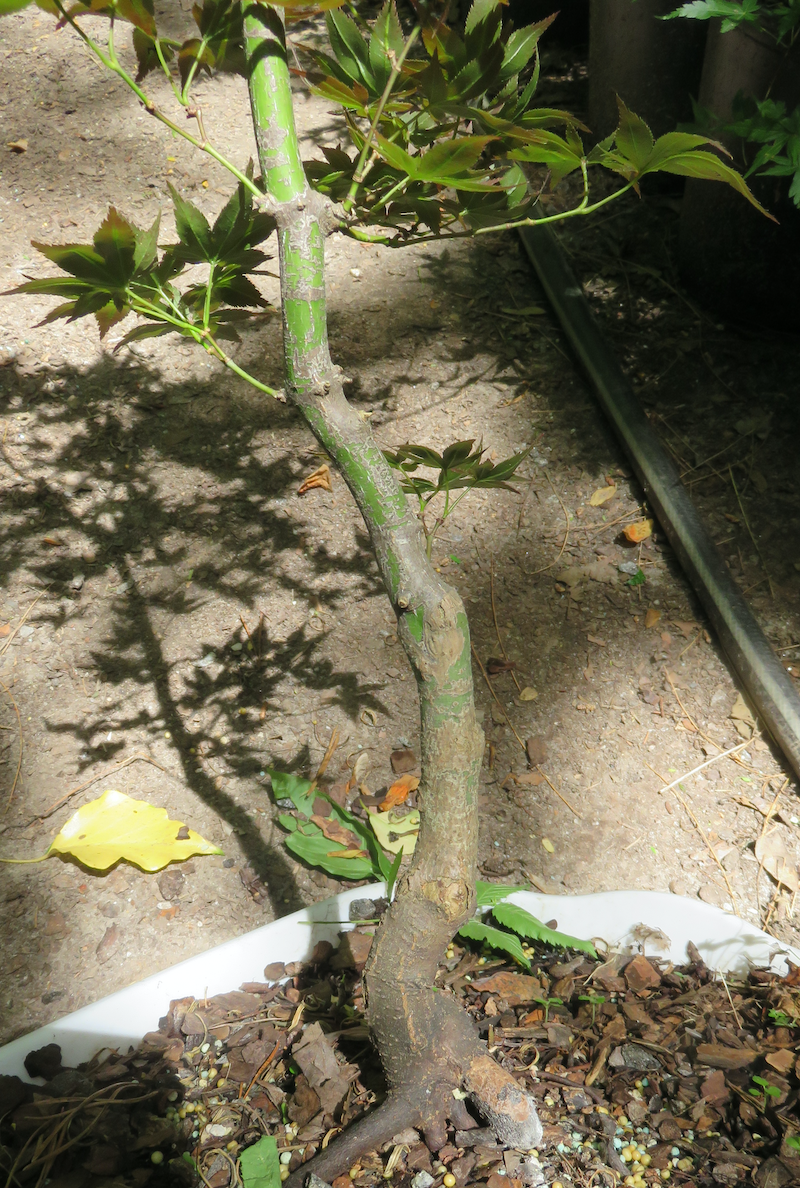Chapter 31 Developing an Initial Styling Plan
Note: this essay incorporates information from these previously published stories and resources.
- Fundamental Bonsai Design - Applying Rules Where None Exist, by Randy Clark, Bonsai Learning Center, Charlotte, NC
- Bonsai Teachers’ Guide, by Bonsai Clubs International, http://bonsai-bci.com
- Bonsai Basic Teaching Program, by Dennis Makishima, Golden State Bonsai Federation, 12/05/2008
Styling a tree can take years, so it is important to have a long-range plan for what you hope to achieve. Randy Clark, founder of the Bonsai Learning Center in Charlotte, NC, nicely summed up the challenges of styling a bonsai tree:
It is almost impossible to formulate a list of rules for the construction of a bonsai. In art, rules are meant to be broken and sometimes bonsai which break all the rules are the most dramatic. Perhaps the word “concepts” or “guidelines” would be more appropriate. Most bonsai have a triangular shape, three primary branches, a viewing front and several elements such as good root displacement, trunk taper and the like.
After repotting a tree for the first time I try to make a general plan for that tree. Having a starting plan guides my decisions for what to remove, what to keep, and what to modify. My initial plan for a tree rarely is its final style; the tree evolves with time and as its growth patterns dictate. Often I start a tree one way then realize later that my original plan is not going to work.
TIP: Don’t try to remember all you learn as you evaluate a tree. Write it down or make sketches in a notebook. Refer back to your notes from time to time as the tree develops to see how your initial observations and ideas change over time.
A few times I have had a tree that had good structure but no obvious best style. When that happened, I focused on keeping the tree healthy and maintaining a flat root mass rather than trying to force it into a particular style. For all but one of these trees, the right style became apparent within a season or two.
31.1 Start By Assessing the Tree Overall
Many factors come together to determine the best style for a tree. So the first step is to to get a general feel for its stronger and weaker elements overall. Do not be too worried that a tree does not have all of these features. Knowing what is missing helps you organize your styling plan.
What feeling inspired by the natural world will the tree try to capture? This is the goal of all styled trees, but the specific feelings to be captured depends on the individual artist and what is inspiring them. Any style that accomplishes this goal for the artist is a good style. If others like the styled tree, so much the better. But always make yourself happy first.
What features make the tree look older and more established? Styling that emphasizes these features usually look better.
- Good solid root spread.
- A tapering trunk, and individually tapering branches.
- Lower branches that tend to bend down, as if weighted by age (higher branches should bend less).
- Movement. Young trees have very straight trunks, while older trees have bends and angles created by harsh weather, light differences, etc.
- Rough textured, mature bark. Younger trees and saplings usually have smoother bark.
- Moss, rocks, etc., that make it seem naturally situated.
- Arranging branches and foliage in layers separated by open space makes the tree look older. Younger trees tend to have all of their foliage in a single mass that hides the branches.
- The tree “embraces” the viewer. A tree that leans slightly forward towards the viewer, and has lower lateral branches that point slightly forward, creates an illusion of greater size, and so greater age.
What will make the tree or grouping aesthetically pleasing? This is tricky because aesthetic ideals differ between cultures. What looks attractive also depends on context.
- Chinese penjing and Japanese bonsai value different pot styles. Penjing artists value deeper containers with decorations that echo the tree’s style. Bonsai artists value shallow pots that fade into the background or are a color that complements the tree’s bark and foliage.
- Traditional Japanese bonsai styles pay close attention to relative proportions. For example, the overall height of a traditionally styled tree should be about six times the width of the nebari at soil level.
- Some styles work much better with certain species than with others. For example, broom style looks great on oaks or zelkovas, but is unattractive on pines.
- Traditional styling rules are meant to make easier for artists to achieve the idealized aesthetic features, NOT to stifle creativity. Sometimes the most pleasing trees will violate stylistic rules. If something looks wrong to you, don’t do it.
Does the tree or grouping tell a story? One of the best ways to make styles more dramatic is to imagine how weather, environment, and other events in the tree’s life have sculpted it. For example, imagine a pine or juniper living on the high slopes of a wind-swept mountain. What features do you expect to see? Why are those features there? Those features tell the life story of that tree.

Windswept foxtail pines in Kings Canyon National Park. Link to original image
In the end your best teacher is personal observation and reflection. Look closely at styled trees you like; what do you like and why? Do the same for full size trees in the wild. What attracts your eye to them? What is their life story? What are the essential elements that tell the story, and what would it take to reproduce them on a smaller scale? Which of those essential elements would make this particular tree more attractive?
31.2 Mark Options For the Front
Once you have a general idea of which features of a tree are the strongest ones, you need to select the side of the tree that you think best shows off these features. This will become the front side that faces viewers when the tree is displayed.
Start by looking at the tree from all sides several times, even if you think one side of the tree is the obvious choice for front. Each time you find a viewpoint you like, put a short stick or piece of wire in the soil; these are your candidates for the front of the tree.
Tip: Many style guides say the front of a tree should have few or no pruning scars or wounds. That is not necessarily true. Some trees actually look better when there is an obvious cavity (uro) on the front of the tree. Uro, a split trunk or similar features often are conspicuous elements of styled flowering apricots, cherries, and crabapple trees.
Now go back and look at the tree from each viewpoint you marked again. Look for the desirable features from the last section. Which points of view show off the nebari? Which points of view match the feeling or memory you want to capture?
Remove the temporary markers for any points of view that you think are not as attractive, or don’t show off the tree’s strong features.
31.3 Look For the Three Primary Scaffold Branches
Now that you have at least one possible choice for the front of the tree, pick one point of view, and look at how the branches are placed. Focus on the first three branches as you move up the trunk from the base.
Looking at the front of the tree, the first or primary branch always should be the lowest, longest and thickest of all the branches on the tree. If it is not the largest, that will need to be corrected later. The first branch usually is no more than one third of the way up the trunk (unless the tree will be in literati style), and should point to the left or right; ideally it will angle forward slightly. The first branch should not be pointing straight ahead towards the viewer, or straight back.
The second branch usually is on the opposite side from the first branch and well above it on the trunk. It is slightly shorter and slightly thinner. It should not be directly opposite of the first branch.
The third or back branch points to the back of the tree, away from the viewer. It is called the third branch because it is slightly smaller and shorter than the second branch; again, relative sizes can be corrected later. The back branch is important because it creates the illusion of greater depth.
Some guides say the point where the back branch emerges from the trunk must always be between the emergence points of the first and second branches. I personally think having a balanced, appealing shape is more important. Once again, it depends more on the preferences of the artist, and how strictly they want to adhere to specific styles.
Once you have assessed the branch options for one point of view, go to the next candidate, and find the first, second, and third branches again. By the time you finish reviewing branch placements, you usually will have a good idea of which side of the tree is the best choice for the front based on the branch placement.
Suppose one particular point of view is extremely attractive, but there are no appropriate first, second, and third branches. Do not discard that option just yet. There ARE ways to develop branches where none exist currently. Just be aware that trying to develop the tree using that particular point of view will take more time and effort than using a point of view with good candidate branches. The other option is to break traditional rules about branch placement.
A Chinese elm in the Longwood Gardens Collection. This tree has been rotated on its display stand so the back side of the tree is facing the viewer. From this point of view, you can see the first branch (bottom right), second branch (pointing left), and third back branch (pointing toward the viewer). The trunk begins with a wide basal flair that tapers smoothly up until the trunk line disappears in the foliage. The first three branches also show a great deal of movement. Link to original image
31.4 Look For Trunk Taper and Movement
Young trees can grow several feet a year. The resulting trunk will have very little taper between the base and apex of the tree. Young trees also tend to grow straight and branch symmetrically. Older trees grow both in height and in diameter simultaneously. The trunk broadens more quickly nearer the roots, creating a visible taper in the trunk as the tree ages. Its straight lines soften into curves and twists in the trunk and branches (what we call movement). The many symmetrical branches of the young tree also give way to more random, asymmetric branching.
If your tree already has taper in the trunk, you want it to be visible from the front. Go back and look at each of your possible front viewpoints again. Does one view show off trunk taper more than the others?
Finally, look at what branches you might need to remove to make the tree look less symmetrical. Is there one viewpoint that shows off existing asymmetry and movement particularly well? Pay special attention to whether you might have to remove one of the candidates for first, second, or third branch.
1. 
2. 
3. 
4. 
5. 
6. 
Young stock trees showing different degrees of movement. All but the last tree are 3-4 years old. Images 1,2. A fringe tree and Japanese maple, both with very straight trunks and little to no movement. Image 3. A second Japanese maple showing some movement in the trunk. There are plenty of side branches I could choose from to develop this particular tree. Images 4,5. A semi-weeping seedling showing extreme movement. Even the smaller side branches (Image 5) already have bends and curves that create visual movement. Despite all of this movement, the trunk still has minimal taper, so that will be part of what I need to develop. Image 6. An older maple (~11 yrs) showing a more mature trunk. The movement of this trunk is accentuated by the taper from the nebari. Original photos by Dan Johnson.
31.5 What Styles Would Be Appropriate?
Now that you have a better sense of the overall structure and stronger features of your tree, start thinking about what bonsai style(s) will best suit it. The main bonsai styles are described here. There are five traditional Japanese bonsai styles, but many other accepted modern forms. Penjing, European, and American styles add more diversity.
Keeping all the styles straight is difficult, so I suggest finding a book that contains photographs or line drawings of the various styles. There are many to choose from, and your own taste will largely determine which book you will like best. Personally, I refer most often to The Bonsai Workshop by Herb Gustafson (Sterling Press, ISBN 978-080690-5570, $19.95). It has written descriptions of the key features of a large variety of styles (both traditional and not), line drawings of idealized trees, and for many styles, photos of trees that fit the style.
What you are looking for is the style (or styles) that seems most compatible with the tree. Remember that very few trees match a particular style perfectly. Every tree will need some work to fully realize the desired style.
The most appropriate styles will create an illusion of something that occurs naturally. They also will build on the existing strong features of the tree. For example, a tree in windswept style is meant to invoke the image of a tree leaning off a cliff. Its root and branch structure will be very different from a tree of the same species in broom style, meant to mimic a tree growing in a meadow. If a tree does not have the essential features needed for a windswept style, then that style is not an option.
The best style for a tree often is decided by its roots. While it is possible to force a treeʼs roots into a different form, it is time-consuming and not always successful. It is simpler to find a style that best suits the roots, then see if the existing branches fit the style too. If so, great. If not, it is time to find out how much the existing structure will need to be changed to fit that style.
One of the journal trees is an extreme example of how underground roots can define the best style for a tree. A second journal tree) illustrates how the basal nebari can overrule what we think is a good style based on the top growth.
31.6 Finalize Your Preferred Front
You should have enough information now to pick the front. This will be the point of view from which you make most of your subsequent styling decisions. Mark the front with a piece of wire or dowel stuck in the soil near the edge of the container.
TIP #1: I learned the hard way to keep the front of each tree in training marked with a dowel or piece of wire. When you have several trees in different stages of training, it is VERY easy to forget which side you chose as the front and prune off something you spent a lot of time developing.
TIP #2: I usually don’t remove my other provisional front markers right away. Instead I use a larger, more obvious marker for the front (usually a curled piece of wire) and keep my provisional markers for a while in case my initial styling plan does not work. It saves me having to relocate the best viewpoints.
31.7 Next Steps
Your initial styling plan is just that: an initial plan. It will change and evolve as you spend time with the tree. The next essay describes some simple techniques that I use to help me see how particular changes will affect the overall style of the tree.
31.8 Putting All of This Together
To show how these elements of styling come together, I’ve made a section in the book with separate journal pages for several trees I started from nursery stock purchased in local garden centers. The journal pages include photos of major steps in styling to show how these trees develop over time, and how each of the styling techniques gets applied.
